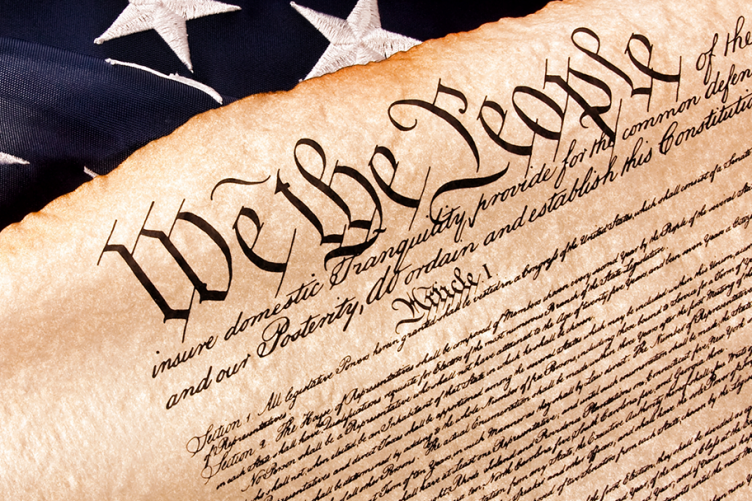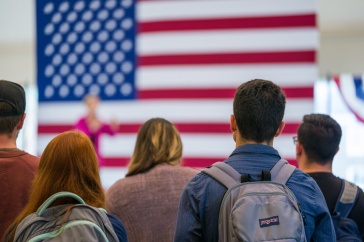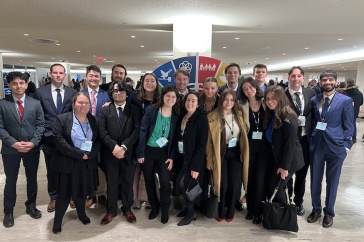
As colleges and universities prepare for Constitution Day, the annual commemoration of the signing of the U.S. Constitution on Sept. 17, 1787, UNH associate professor of political science Susan Siggelakis reflects on the country’s response to the coronavirus and Constitutional rights.
Since last March, students, faculty members and their families have endured lockdowns in their homes, restrictions on travel, closure of or restrictions on their businesses, limits on gatherings in public spaces and prohibitions on public worship, just to mention a few. Though the situation has eased somewhat, we are now hearing that the government may begin using ‘contact tracing’ via our phones as one way to track those who may be infected. Mandatory mask use and temperature-taking is required for entry into state and federal buildings across the country. Legal proceedings, such as arraignments and trials, have been postponed and or gone virtual. The majority of these measures have been instituted by state governors, in some cases through executive order and, in many cases, accompanied by a declaration of emergency.
No question exists that both federal and state constitutional rights were impinged. Did these governors act unconstitutionally, albeit for important reasons—the public health? What is the balance between rights and the safety of the community during an extraordinary event like COVID-19? Who decides what government may and may not do to individuals for the ‘greater good?’ Are our rights to speech, travel, property, privacy, a fair and public trial, association, free exercise of religion absolute during a pandemic? Are rights, once surrendered during an ‘emergency,’ likely to continue to erode even after the ‘emergency’ is over?
For an answer to these questions, a good place to begin is the U.S. Constitution. Under our Constitution, states possess what is known as the “police power,” which is the power to regulate for the health, safety and welfare of its citizens. Because the states predate the union, they retain all powers that they did not surrender to the national government in the course of ratifying the Constitution. This is enshrined in 10th Amendment.
While our nightly news is filled with updates on what the president, Congress and federal agencies are doing (or thinking of doing), the real power lies in the states because they possess police power. States have always been diverse, not only in their climates, geographies, demographics, etc., but also in their local cultures and values. For this reason, the framers (of the Constitution) knew it was wise to leave the bulk of governmental power to the states. Accordingly, state governments would be the most responsive to their own unique, current conditions. In the case of COVID-19, states have been affected by the virus in very different ways. For example, South Dakotans barely experienced the outbreak and they required few measures of their state government, while New York—particularly New York City—appeared at times to be in a full-blown crisis. It was almost impossible not to turn on the TV without seeing Gov. Andrew Cuomo giving updates and urging compliance with state measures.
With this police power comes coercion. Of course, coercion is implicit in all government action. Thus, the more important question is: coercion for what end? For ends that we accept or those we do not? And what degree of coercion will we accept, particularly in a society such as ours, one founded on the natural rights of life, liberty and the pursuit of happiness?
As Alexis de Tocqueville once wrote, “there is no political question in the United States that is not resolved sooner or later into a judicial question.” Accordingly, the 1905 United States Supreme Court decision in Jacobson v. Massachusetts is helpful in giving us some sense of the limits of police power. In Jacobson, the petitioner (the party appealing the lower court’s decision) challenged a state law requiring compulsory vaccination. Petitioner Henning Jacobson had refused to be inoculated against smallpox and was convicted for his failure to comply with the Massachusetts statute requiring it. The U.S. Supreme Court found for the Commonwealth of Massachusetts, upholding both the law and Henning’s conviction.
Speaking for the 7-2 majority, Associate Justice John Marshall Harlan wrote that the Constitution “does not import an absolute right in each person to be at all times, and in all circumstances, wholly freed from restraint.” He reasoned, “A community has the right to protect itself against an epidemic of disease which threatens the safety of its members.” Its members “may at times, under the pressures of great dangers, be subjected to such restraint, to be enforced by reasonable regulations, as the safety of the general public may demand.”
Decades later, another justice, Arthur Goldberg, would summarize Harlan’s line of reasoning this way: “While the Constitution protects against invasions of individual rights, it is not a suicide pact.”
On the other hand, most government measures must be “rational,” (rationally related to a legitimate state interest). For instance, laws requiring that drivers be licensed before they take to the roads are rational because, as you probably learned in driver’s ed, driving is not a right but a privilege. However, when measures limit Constitutional rights, such as the right to travel, vote or assemble (e.g., engaging in peaceful protest), they must meet a higher burden.
Such measures must survive what is called “strict scrutiny.” In legal language, laws that affect these fundamental rights must be “narrowly tailored” to “achieve a compelling (not simply important) state interest.” Narrowly tailored means that the government must use the least restraint possible to achieve its desired goal. For example, forbidding people to leave their homes during the outbreak, which clearly affects a liberty interest protected by the 14th Amendment, would likely be struck down as not narrowly tailored to meet the compelling state interest of protecting the public health. That is to say there are many less draconian measures the government could take to limit the spread of infection. For example, the government could require citizens to wear masks outside the home, engage in social distancing, etc. In applying the Constitution, the courts must balance infringement on fundamental rights with the achievement of an absolutely essential benefit to society.
Yet, we might also wonder if reducing the spread of the virus meets the criteria of a compelling state interest. Might this depend how likely the average citizen is to die of the virus if he or she contracts it? Perhaps a fatality rate of 5.3%, as documented by the Johns Hopkins Coronavirus Resource Center, means the measures taken serve an important — but not compelling — state interest, especially given that the virus mainly affects the elderly and those with preexisting conditions.
Currently, a relevant and illustrative case is winding its way through the Michigan state courts. In May, a 77-year-old barber, Karl Manke, reopened his business in defiance of the executive orders of Gov. Gretchen Whitmer, as well as orders issued by the Michigan Department of Health and Human Services. Manke had operated his barbershop for 59 years without any complaints or adverse action against his license. Although the case has many procedural twists and turns, the crux of his argument has been that the orders he disobeyed present numerous constitutional violations.
Manke argues, for instance, that the governor’s actions do not withstand strict scrutiny, particularly violating the ”compelling interest” component of the test, as other businesses such as Walmart, Taco Bell and General Motors have been permitted to operate. Furthermore, even if the state’s interest was compelling, he questions whether shutting down businesses such as his was the least restrictive means to achieving that interest. Were there not less drastic measures that could have equally or better achieved the same results?
Second, he argues that the shutdown order violated his 14th Amendment right to equal protection. This means that laws must apply equally to all those in like situations. Thus, if Taco Bell could be open, so too should Manke’s shop. As similarly situated businesses dealing with the public in face-to-face interactions, treating them differently violated his right to equal protection. Indeed, a fast food worker comes into contact with exponentially more people per day than a lone barber and, therefore, might pose a greater risk to public health than a barbershop would. He further argues that the orders impede his constitutional right to travel, protected by the Due Process Clause of the 14th Amendment, because it limits access to a place through public spaces and roadways.
Last, but not least, he argues that Article I, Section 10 of the U.S. Constitution, which holds that “no State may pass any law impairing the obligation of contracts,” was violated when Whitmer’s orders arbitrarily allowed some businesses to continue operating (thus fulfilling their contracts with workers, landlords, suppliers, distributors, customers, etc.) and forced other unfavored businesses, like Manke’s, to close and breach their contracts.
In sum, Manke’s attorneys presented the case that although his business never posed an imminent threat to public health or safety, a number of his constitutional rights were violated by the State of Michigan, causing him irreparable harm. Recently, the Supreme Court of Michigan ruled in Manke’s favor, holding that “it is incumbent on the courts to ensure decisions are made according to the rule of law, not hysteria.” Despite this victory, Manke v. Michigan case may very well end up on the docket of the U.S. Supreme Court next term. This would provide the highest court in the land a new opportunity to elucidate how the framers of our Constitution sought to balance the inalienable rights of the individual with the health and safety of the community

















































